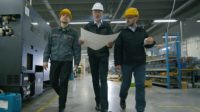Management
Protecting Quality When Tariffs Tighten the Screws
In a post-tariff environment, quality is also about operational agility.

Image Source: Portra / E+ / Getty Images Plus
When tariffs hit key materials like steel and aluminum, the ripple effects aren’t limited to the supply chain—they extend all the way down to quality assurance. Many companies feel the pressure acutely -- budgets get tighter, equipment becomes harder to replace, and any delay or breakdown becomes significantly more costly.
That is where technology tools step in and can make a huge difference to an operation. Tech tools such as enterprise asset management (EAM), IT asset management (ITAM) and Computerized Maintenance Management System (CMMS) are proving to be unsung heroes in the construction industry these days, not just for operational efficiency, but for protecting quality and controlling costs in a time of economic volatility.
Let’s dig into this a bit—because when you think about construction, advanced technologies probably aren’t the first thing that comes to mind.
Extending Equipment Lifecycles with Preventive Maintenance
One of the most immediate impacts of tariffs is the skyrocketing cost of heavy equipment. Cranes, bulldozers, scaffolding—every piece of gear on a job site becomes a capital investment you can’t afford to lose. EAM platforms provide construction firms with a smarter way to manage those assets through preventive maintenance.
Rather than reacting to breakdowns, these technology solutions can help teams get ahead of problems—scheduling service before failure, tracking usage data, and identifying wear patterns early. This approach not only maximizes uptime and minimizes costly disruptions but also extends the usable life of equipment.
When buying a new crane might cost 20% more post-tariff, keeping your existing one in top shape becomes mission-critical for both quality and the bottom line.
Asset Visibility Across Distributed Workforces
Construction sites are notoriously dynamic. Equipment, people, and technology are constantly on the move—across job sites, regions, and even countries. That mobility can easily lead to asset loss, security risks, or digital disconnects that compromise both productivity and quality.
ITAM systems offer visibility into mobile devices, laptops, tablets, and even software licenses. Knowing exactly where your digital tools are—and whether they’re updated, compliant, and secure—ensures smoother collaboration and reduces costly missteps in the field.
Smarter Planning and Budgeting
Tariffs don’t just impact today’s costs—they reshape tomorrow’s planning too. When prices for materials and equipment are unpredictable, capital budgeting becomes a high-stake guessing game. But with the right data from your asset management system, that guesswork becomes more strategic.
By analyzing usage trends, maintenance histories, and lifecycle forecasts, asset management systems allow leaders to better predict when assets will require replacement or major repair. This kind of foresight supports more informed planning—helping teams invest wisely and avoid sticker shock surprises. It also helps align spending with quality goals, ensuring you’re not just saving money, but maintaining performance standards across projects.
Let’s face it—when your own equipment breaks down or goes missing, that can kill your budget. Asset management and CMMS tools enable companies to build more self-reliant operations, where equipment is maintained proactively, downtime is minimized, and quality output negatively impacted. It’s a win-win -- less financial waste, and fewer compromises on quality due to rushed workarounds.
Quality and Cost Control Go Hand in Hand
Quality is often the first casualty when budgets tighten—but it doesn’t have to be. With the right approach, companies can navigate tariff-related volatility while strengthening operational performance.
Today, technology isn’t just a back-office tool—it’s a frontline driver of cost control and quality assurance. From ensuring equipment reliability to keeping teams connected and projects on schedule, tech plays a critical role in maintaining performance amid economic uncertainty.
Traditionally, quality has been associated with craftsmanship, materials, or regulatory checklists. But in a post-tariff environment, quality is also about operational agility. Smart technology ensures the right people have access to the right tools—functioning properly, at the right time, and within budget. That’s the backbone of consistent, high-quality outcomes.
While construction is a prime example, the same principles apply across industries—from manufacturing and utilities to education and healthcare. Wherever asset-heavy operations meet economic headwinds, proactive management makes all the difference.
Because quality doesn’t happen at the final inspection—it’s built in from the start. And that starts with visibility, data, and forward-looking strategies. When delays are costlier, breakdowns more disruptive, and parts harder to source, your best defense is a tech-enabled approach that keeps work flowing and standards high—no matter what is thrown your way.
Looking for a reprint of this article?
From high-res PDFs to custom plaques, order your copy today!






